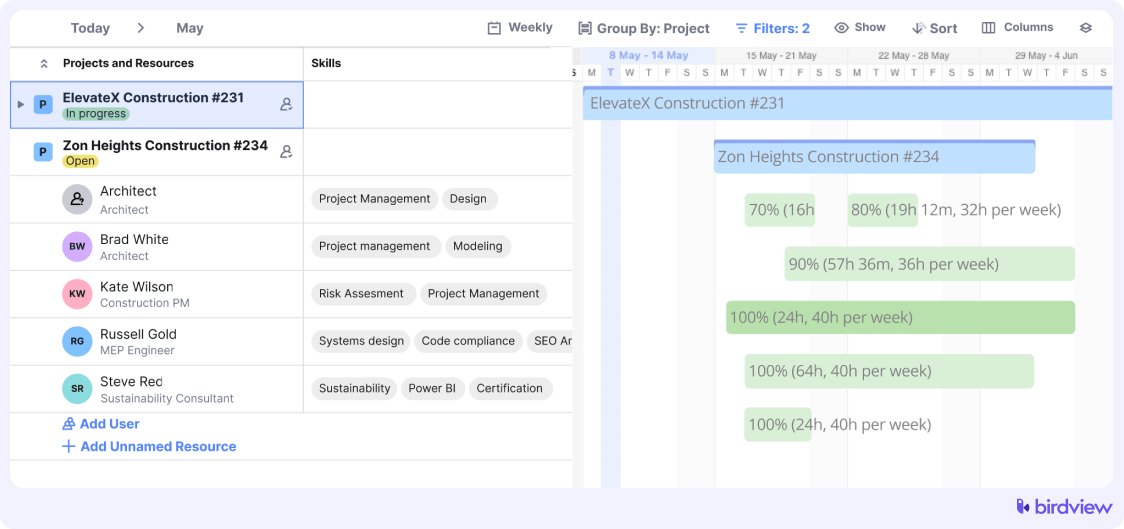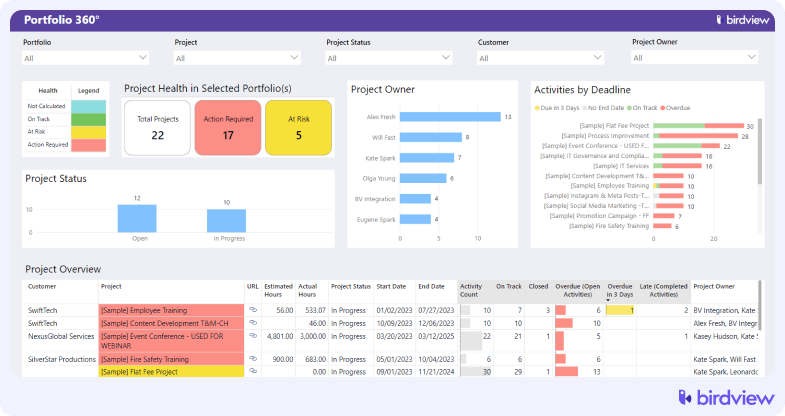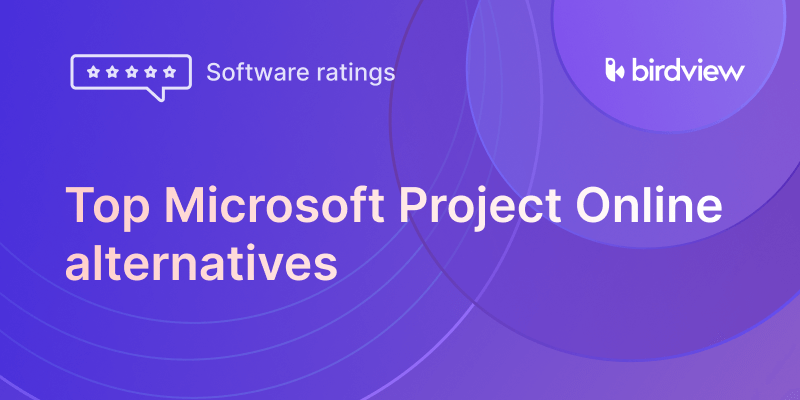Coordinating dozens of projects, people, and priorities can quickly turn into chaos without a plan. For PMO leaders, consultants, and portfolio managers, success starts with what gets approved in the first place. That‘s why project intake and portfolio prioritization are critical to building a high-impact project portfolio. As a result, they are better equipped to choose the work that drives results and maintains portfolio-level alignment with business strategy.
What is project intake?
Project intake is the structured process of capturing and submitting new project ideas, requests, or proposals for evaluation. These may come from internal teams, department heads, or external stakeholders. A strong intake process ensures every idea is reviewed fairly, consistently, and with enough detail to support sound decision-making. Without it, portfolios grow based on whoever shouts the loudest or submits the flashiest deck.
Project intake helps organizations stay aligned with strategy and avoid the chaos of unclear priorities or last-minute approvals. Without it, portfolios grow based on whoever speaks loudest or submits the flashiest request.
Common pitfalls in project intake
Even with the best intentions, many organizations struggle to manage incoming project requests effectively. Without a structured intake process, portfolios can quickly become cluttered, misaligned, or overwhelming.
Unstructured submission methods
Project ideas often arrive through informal channels, such as emails, chat messages, and hallway conversations. As a result, it becomes hard to track, compare, or follow up. Without a centralized system, valuable opportunities can get lost or overlooked.
Missing business context
Proposals sometimes lack essential details like estimated costs, strategic alignment, or expected outcomes. This makes it nearly impossible to evaluate the potential impact of a project or justify its inclusion in the portfolio.
No intake ownership
When no one is assigned to review and manage incoming requests, ideas can sit idle or fall through the cracks. Clear intake ownership ensures every request is acknowledged, reviewed, and routed appropriately.
Overwhelming volume of requests
Without prioritization, the intake process becomes a backlog of competing demands, many of which don‘t align with business goals. This overload can stall decision-making and lead to reactive, low-impact project selection.
This overload can stall decision-making and lead to reactive, low-impact project selection – weakening the overall portfolio strategy.
📚 Read more: 8 project portfolio management mistakes and how to fix them
Why project prioritization is essential in portfolio management
Once project requests are collected, not everything can move forward, and that‘s where prioritization comes in. It‘s the process of evaluating and ranking project proposals based on their strategic value, feasibility, risk, and available resources. Portfolio prioritization is one of the most important steps in the project portfolio management process.
Project prioritization is how organizations make smart trade-offs. Done right, it helps focus time, talent, and budget on the initiatives most likely to drive business goals. Without it, teams spread themselves too thin, chase low-value work, and struggle to meet deadlines.
Common challenges in project portfolio prioritization
Even with a clear strategic vision, prioritizing the right mix of projects is rarely straightforward. Leaders often face competing requests, limited visibility, and shifting goals, all of which make it difficult to objectively decide what to greenlight and when. Without a solid prioritization framework, teams risk spreading resources too thin, overcommitting to low-impact work, or missing out on high-value opportunities that could elevate overall portfolio performance.
Misaligned priorities across departments
Different teams often advocate for their own needs without considering the broader organizational strategy. Without a shared portfolio prioritization framework, this can lead to conflict, delays, or biased decision-making that doesn‘t serve the big picture.
Lack of objective evaluation criteria
When prioritization is based on gut feelings or loudest voices rather than standardized scoring, decisions become inconsistent and hard to justify. This often leads to unclear trade-offs and reactive planning instead of strategic execution.
Limited visibility into resource constraints
You can‘t prioritize work effectively if you don‘t know whether your teams have the bandwidth to execute. Many organizations prioritize projects in isolation, without checking capacity or availability, leading to overcommitment and burnout.
Static prioritization in a dynamic environment
Markets shift, priorities evolve, and new opportunities emerge. If your prioritization approach doesn‘t allow for regular updates or scenario planning, your portfolio can quickly become misaligned with current business needs.
Inconsistent stakeholder involvement
Too few people are involved, and decisions lack perspective. Too many, and the process becomes slow or political. When the wrong stakeholders are included, or key ones are missing, portfolio prioritization loses its effectiveness and credibility.
📚 Read more: What does a portfolio manager do in project management?
How project intake and prioritization help you make smarter portfolio decisions
In project portfolio management, intake and prioritization aren‘t just routine steps. They are how you shape the future of your entire portfolio.
A clear intake process helps you collect the right ideas with enough detail to understand what they are really about. Portfolio prioritization then helps you decide which ones are actually worth doing, based on your goals, resources, and timing.
When these two processes work together, they help you:
- Build a healthy mix of projects: some low-risk, some high-reward, some innovative
- Avoid repeating work across teams or running similar projects in silos
- Stay flexible by updating your priorities as business needs change
This is why intake and prioritization are not just administrative tasks. They are essential for managing your portfolio with intention so you can focus on the work that truly matters.
Who is involved in portfolio-level intake and prioritization?
To manage intake and prioritization effectively across a portfolio, several key roles are involved:
- PMO leaders own intake systems, scoring frameworks, and portfolio reporting
- Portfolio managers ensure strategic alignment and balance across projects
- Resource managers validate capacity and delivery feasibility
- Finance and strategy teams evaluate business cases and ROI
- Executive sponsors or steering committees approve or reprioritize based on changing business needs
A step-by-step guide for better project intake and prioritization
Establishing a consistent, repeatable intake and prioritization process is critical for managing your project portfolio with confidence. Without it, ideas pile up, decisions get delayed, and teams end up working on the wrong things. A structured process helps ensure that every approved project is aligned with strategy, backed by available resources, and capable of delivering real value. Each step below contributes directly to the health, visibility, and value of your entire portfolio.
Step 1: Establish intake channels and templates
Start by creating a single, centralized channel where project ideas can be submitted, whether from internal teams, clients, or executives. Intake should be standardized with clear templates or forms that capture essential information like goals, timeline, estimated cost, and strategic relevance.
✅ Use custom intake forms to capture requests consistently. Each form can feed directly into a request pipeline, giving the PMO and decision-makers full visibility into upcoming demand.
Step 2: Define evaluation criteria and scoring models
Once requests are submitted, you need a consistent way to evaluate them. Create scoring criteria based on value, cost, risk, strategic fit, and other factors that matter to your organization. This helps you move from subjective opinions to data-backed decisions.
✅ Use custom fields to assess each project against defined evaluation metrics. This makes comparisons between proposals faster and more transparent.
Step 3: Involve the right decision-makers
Portfolio prioritization and approvals should involve a cross-functional group of stakeholders, including PMO leaders, department heads, finance, and resource managers. These stakeholders bring the strategic, financial, and operational perspectives needed to make well-rounded decisions.
✅ Use approval workflows and role-based permissions to route requests to the right people automatically, ensuring every proposal is reviewed by the appropriate stakeholders.
Step 4: Assess resource availability early
Before approving a project, you need to confirm whether you have the people and capacity to deliver it. Many portfolios fall short not because of bad ideas, but because they‘re launched without the needed resources in place.
✅ The Resource Planning and Workload View tools give real-time insights into availability by role, skill set, and department, so you can flag potential conflicts and adjust plans before work begins.

Step 5: Review, rank, and approve based on objective data
With intake information, evaluation scores, and resource insights in place, it’s time to review proposals and prioritize them. Use a scoring model, value-risk matrix, or custom dashboards to rank projects and approve those with the strongest business case.
✅ Portfolio dashboards let you visualize project proposals, filter by key metrics, and surface top-priority initiatives. Decision-makers can sort and compare projects at a glance.

Step 6: Track outcomes and continuously improve
Once projects are underway, it‘s important to measure whether the intake and prioritization process led to positive outcomes. Review actual ROI, delivery performance, and resource usage to refine your scoring criteria and improve future intake cycles.
✅ Use Business Intelligence Dashboards to track project outcomes across your portfolio. This data loop helps teams learn from each cycle and fine-tune decision-making over time.
How Birdview PSA helps streamline intake and prioritization
Birdview PSA gives portfolio teams a connected system to streamline project intake and prioritization from start to finish.
- Centralized request intake forms and custom fields: Create custom intake forms that collect consistent information for every proposal. Standardize how project data is submitted, stored, and reviewed.
- Portfolio-level visibility to assess impact and alignment: View all incoming proposals in one place and filter by business unit, strategic goal, or value score to understand what fits best.
- Built-in prioritization tools: Rank project ideas objectively and make smarter decisions faster.
- Real-time resource and capacity insights for feasibility checks: Instantly see team availability and ensure you‘re not approving work you can‘t support.
- Seamless handoff from intake to planning, scheduling, and execution: Once a project is approved, Birdview links it to downstream workflows like scheduling, budgeting, and time tracking. No need to re-enter data.
📚 Read more: Benefits of project portfolio management for service firms
Final thoughts
Too many project portfolios fail before they even begin, not because of poor execution, but because the intake and prioritization process is rushed, inconsistent, or disconnected from strategy. When ideas enter the system without proper vetting, or when teams chase the loudest request instead of the most valuable, it becomes nearly impossible to deliver meaningful results.
The truth is, your entire portfolio depends on how well you choose what to work on. A clear, standardized process for project intake and portfolio prioritization helps prevent wasted effort, ensures your teams are working on the right things, and gives you the visibility to make better, faster decisions.
Birdview PSA was built with this reality in mind. From structured intake forms and scoring models to real-time resource planning and portfolio dashboards, it gives PMOs and project leaders the tools to start strong and stay focused. If your current process is holding you back, it might be time to try a more scalable approach.



